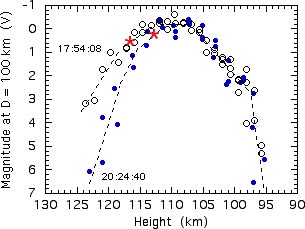|
Leonid MAC |
| home |
| View the shower |
| Mission Brief |
| Science Update |
| Media Brief |
| links |
LEONID DAILY NEWS: November 3, 2000
Figure right: Snapshot of the infrared light from a meteor.
THE PALE (INFRA-RED) DOT
Imagine the disappointment when after a night's hard work all that is detected is
a pale dot of indisciminate colour. This is what happened to
George Rossano and
co-workers at the Aerospace Corporation during the 1998 Leonid MAC.
Two dots to be precise. Rossano deployed a mid-infrared imager "MIRIS" that was set to
catch the warm glow of a Leonid meteor at wavelengths between 3.0 and 5.5 micron.
After comparing numerous detections of meteors by intensified video cameras with his
infra-red images, Rossano found all but two dots of light, from two meteors at
17:54:08 and 20:24:40 UT, November 17, respectively.
More carefull comparison, however, showed that those dots did match with the video
record of the meteors, in both cases representing a specific point just before the
peak brightness at visible wavelengths. Moreover, those dots were rather bright,
the luminosity being 25 times that at optical wavelengths.
Figure left: The brightness of the meteor at different altitudes.
The meteors were seen from both aircraft, the FISTA and Electra, and triangulation
made it possible to calculate the height of the observed phenomenon.
It was found that the two pale dots were detected at 117 and 113 km altitude, respectively,
at much the same position in the meteor's lightcurve (red stars in graph to the left).
Was it the instrument that caused only a sliver of the meteor to record on the sensors?
Partly, yes. The instrument took very brief exposures at a rate of 16 per second. In a longer
exposure, a short track rather than a dot would have been detected.
However,
the meteor was of much longer duration than 1/16th of a second. More dots in Rossano's
record should have
lined up with the meteor path. Carefull examination of the record shows
no other trace. Hence, for some unknown reason, meteors do not look the same in the
infrared as in the visible.
What mystery lays before us? What is the significance of such pale dot?
Remembering the words of a famous astronomer watching the pale blue dot of planet
Earth on an image taken far from home, the following comes to mind.
Did all your friends, all your family, all people we know or ever lived,
all animals and plants, all living organisms on Earth originate from this brief
moment in the meteor's demise, when organic matter was released in a fragmentation
event?
Rossano and colleagues think not. Something else than organic matter is
responsible for the bright warm glow of the meteor just before its visible peak. The
lack of the detection of a spectrum suggests that most of the emission came out
longward of 4 micron, rather than in the 3.4 micron region that contains the
organic signature fingerprint. Solid body heat emission could have generated such
light, but only if the temperature at 115 km altitude is less than 800 K. Why the
meteor IR emission subsequently quickly fainted remains a mystery at this
time (Full paper - PDF).
Nov. 03 - The pale (infra-red) dot Nov. 02 - Twin showers Nov. 01 - Leonids approaching Earth Oct. 31 - Prospects for Moon Impact Studies Oct. 30 - Comet dust crumbled less fine
| ||



